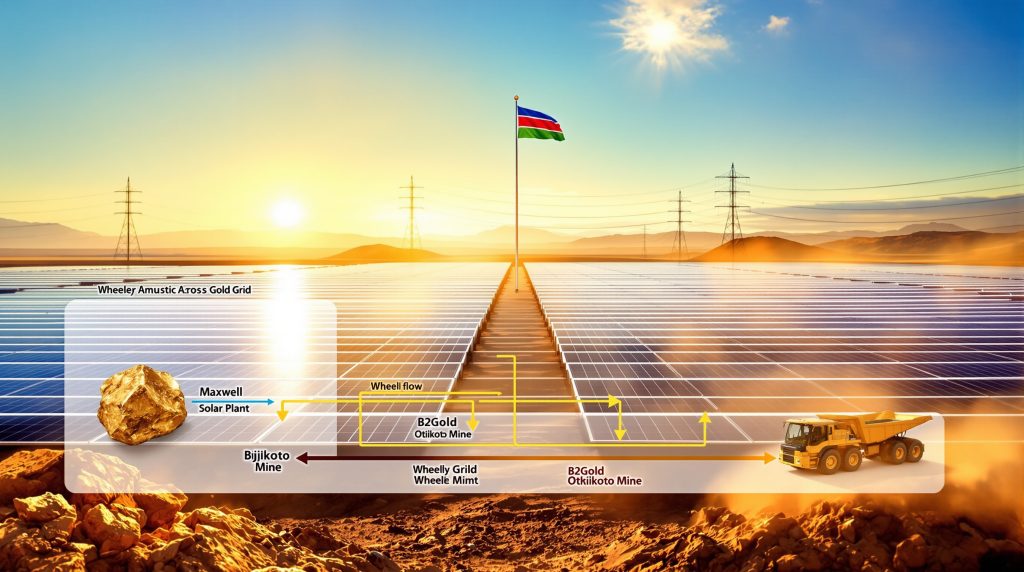What is Solar Wheeling and Why is it Important for Namibia's Energy Future?
Solar wheeling represents a significant evolution in Namibia's energy landscape, allowing private power producers to sell electricity directly to large consumers through the national grid. This innovative approach bypasses traditional single-buyer models where all power had to be sold to the national utility. The concept enables more flexible energy markets and creates pathways for industries like mining to access renewable energy regardless of their physical location relative to generation sites.
For Namibia, solar wheeling addresses several critical challenges:
- Reducing dependence on imported electricity from neighboring countries
- Accelerating renewable energy adoption in energy-intensive industries
- Creating a more competitive electricity market with diverse participants
- Supporting national climate commitments and sustainability goals
- Enabling private investment in energy infrastructure
The Modified Single Buyer (MSB) programme specifically creates the regulatory framework to facilitate these transactions, marking a fundamental shift in how energy is bought, sold, and distributed throughout the country.
Namibia currently imports approximately 60% of its electricity needs, primarily from South Africa's Eskom, creating significant energy security vulnerabilities. This dependence costs the country approximately N$4 billion annually in foreign currency outflows that solar wheeling arrangements could help reduce.
With solar irradiation levels averaging 2,200-3,000 kWh per square meter annually—among the highest globally—Namibia offers exceptional conditions for solar energy development. The country's renewable energy target aims for 70% renewable electricity generation by 2030, requiring approximately 294 MW of additional renewable capacity beyond current installations.
The Maxwell Solar Project: First of Its Kind in Namibia
Project Overview and Location
The Maxwell Solar Plant represents a groundbreaking development as Namibia's first solar wheeling project under the MSB programme. Located approximately 50 kilometers north of Otjiwarongo on Maxwell Farm in north-central Namibia, this 10 MW solar facility demonstrates how renewable energy can be generated in one location and consumed in another through NamPower's transmission infrastructure.
The project's strategic positioning takes advantage of Namibia's abundant solar resources while addressing the energy needs of a major industrial consumer located elsewhere. This innovative approach maximizes the utility of both natural resources and existing grid infrastructure.
Key Project Partners and Their Roles
The Maxwell Solar initiative brings together several key stakeholders, each contributing unique expertise and resources:
-
Sustainable Power Solutions (SPS): Lead developer providing funding, technical expertise, and operational management for the solar plant
-
B2Gold Namibia: Major offtaker and strategic partner, purchasing the renewable energy for its Otjikoto gold mine
-
The Oelofse Family: Landowners of Maxwell Farm and co-investors in the project
-
Fortitude: Property developer that facilitated connections between key stakeholders
-
NamPower: National utility enabling transmission through its grid infrastructure
-
Namibia's Electricity Control Board: Regulatory authority overseeing the MSB framework
This collaborative approach demonstrates how public-private partnerships can accelerate renewable energy deployment when supported by appropriate regulatory frameworks.
Technical Specifications and Investment Details
The Maxwell Solar Plant represents a significant investment in Namibia's renewable energy sector:
-
Capacity: 10 MW solar photovoltaic installation
-
Annual Generation: Approximately 26,360 MWh of clean electricity
-
Investment Value: Approximately N$200 million (US$10.6 million)
-
Grid Connection: Feeds into NamPower's Eldorado substation
-
Carbon Impact: Offsets roughly 26,360 tonnes of CO2 emissions annually
-
Commercial Structure: Unique 8-year power purchase agreement (PPA), shorter than the typical 20-25 year term
The project demonstrates how solar energy can be deployed at scale with significant environmental benefits while maintaining commercial viability, even with non-standard PPA terms aligned with mine life considerations.
How Does the Modified Single Buyer Programme Work?
Regulatory Framework and Market Evolution
Namibia's MSB programme represents a significant evolution from the previous single-buyer model that restricted independent power producers (IPPs) to selling electricity exclusively to NamPower. The new framework creates a more dynamic electricity market by:
-
Allowing direct transactions between generators and large consumers
-
Establishing clear rules for grid access and wheeling charges
-
Creating transparent mechanisms for billing and settlement
-
Setting technical standards for grid connection and operation
-
Defining roles and responsibilities for all market participants
This regulatory innovation unlocks approximately 400 MW of potential private sector generation capacity, primarily targeting solar PV development due to Namibia's exceptional solar resources.
Wheeling Mechanics: From Generator to Consumer
The wheeling mechanism under the MSB programme involves several key steps:
-
Generation: The IPP produces electricity at its facility (in this case, the Maxwell Solar Plant)
-
Grid Injection: Energy enters NamPower's transmission network at a specified entry point
-
Transmission: Electricity flows through the national grid
-
Allocation: The energy is virtually allocated to the contracted consumer
-
Consumption: The end user (B2Gold's Otjikoto mine) consumes electricity from the grid
-
Settlement: Financial transactions occur based on metered generation and consumption
This process allows renewable energy to be "wheeled" across significant distances while maintaining system stability and reliability. The 20-kilometer separation between the Maxwell Solar Plant and the Otjikoto mine demonstrates how geographical constraints can be overcome through this approach.
Benefits for Independent Power Producers and Consumers
The MSB framework creates substantial advantages for both power producers and consumers:
For Independent Power Producers:
- Access to a broader customer base beyond the national utility
- Ability to negotiate market-based pricing with consumers
- Reduced dependency on single-buyer procurement processes
- Opportunities to develop projects based on consumer needs
- Potential for portfolio diversification with multiple offtakers
For Large Consumers:
- Direct access to renewable energy regardless of location
- Potential cost savings compared to traditional supply options
- Enhanced energy security through diversified supply
- Improved environmental performance and carbon footprint
- Support for corporate sustainability commitments
These mutual benefits create strong incentives for market participation and renewable energy development.
B2Gold's Renewable Energy Journey
Previous Renewable Energy Initiatives
B2Gold's commitment to renewable energy at its Otjikoto operation predates the Maxwell Solar project. The company has demonstrated progressive leadership in sustainable mining transformation through:
-
Commissioning a 7 MW on-site solar plant in 2018
-
Transitioning from complete reliance on heavy fuel oil in 2015
-
Achieving 13% renewable energy supply prior to the Maxwell project
-
Implementing energy efficiency measures across operations
-
Establishing clear corporate emissions reduction targets
These earlier initiatives provided valuable experience and demonstrated the technical and economic viability of renewable energy in mining operations, creating a foundation for the more ambitious Maxwell Solar partnership.
Impact on Mine Operations and Sustainability Goals
The addition of the Maxwell Solar Plant significantly advances B2Gold's sustainability objectives:
-
Substantially increases the renewable energy portion of the mine's power mix
-
Supports B2Gold's global target of reducing greenhouse gas emissions by 30% by 2030
-
Enhances energy security through supply diversification
-
Demonstrates leadership in sustainable mining practices
-
Creates a model for other mining operations in Namibia and beyond
-
Potentially reduces operational costs through competitive renewable energy pricing
B2Gold Namibia's Country Manager emphasized the company's ambition to lead Namibia mining news in renewable energy adoption, with the Maxwell project serving as a cornerstone of this strategy.
Economic Benefits and Risk Management
The solar wheeling arrangement provides B2Gold with several economic advantages:
-
Cost Predictability: Long-term price stability compared to fossil fuel alternatives
-
Reduced Exposure: Less vulnerability to fuel price volatility and supply disruptions
-
Enhanced Competitiveness: Potential operational cost advantages
-
Alignment with Mine Life: The 8-year PPA structure matches the approved life-of-mine plan
-
Reputational Benefits: Strengthened social license to operate through environmental leadership
-
Regulatory Compliance: Positioning ahead of potential carbon regulations or taxes
These benefits demonstrate how renewable energy integration can serve both environmental and economic objectives for mining operations.
Challenges and Solutions in Project Development
Pioneering a New Regulatory Framework
As the first project under Namibia's MSB programme, the Maxwell Solar initiative faced several unique challenges:
-
Navigating untested regulatory processes and requirements
-
Establishing precedents for future projects to follow
-
Coordinating with multiple stakeholders across public and private sectors
-
Defining technical standards for grid integration
-
Developing commercial models suitable for all parties
-
Balancing innovation with risk management
SPS's representative noted that "the first project is always the hardest," highlighting how the team worked closely with NamPower and the Electricity Control Board to shape a workable model that could serve as a template for future developments.
Adapting Commercial Structures to Mining Realities
The project team developed innovative solutions to align renewable energy development timelines with mining operational realities:
-
Shorter PPA Term: The 8-year agreement deviates significantly from the typical 20-25 year solar project contracts
-
Risk Allocation: SPS assumed "unique risk" by accepting the shorter term aligned with Otjikoto's approved life-of-mine
-
Future Flexibility: Planning for potential expansion and battery storage integration
-
Alternative Offtake Strategies: Considering options for power sales after the initial PPA period
-
Modular Design: Enabling potential relocation or reconfiguration as needs evolve
These adaptations demonstrate how renewable energy business models can be customized to meet the specific needs of mining operations with defined operational lifespans.
Technical Integration and Grid Management
Successful implementation required addressing several technical challenges:
-
Ensuring grid stability with variable renewable generation
-
Establishing appropriate metering and settlement systems
-
Defining technical requirements for connection and operation
-
Managing potential transmission constraints
-
Coordinating with NamPower's system operations
-
Planning for future expansion and technology integration
The successful resolution of these challenges created valuable technical precedents for future projects under the MSB framework.
Future Outlook for Solar Wheeling in Namibia
Expansion Plans for Maxwell Solar
The Maxwell Solar project partners have already identified several opportunities for future development:
-
Potential capacity expansion beyond the initial 10 MW
-
Integration of battery energy storage systems to enhance dispatchability
-
Exploration of additional offtake arrangements with other consumers
-
Incorporation of advanced monitoring and optimization technologies
-
Evaluation of hybrid generation options to enhance reliability
-
Development of complementary projects in the region
These expansion plans demonstrate confidence in the viability of the solar wheeling model and commitment to long-term renewable energy development in Namibia.
Implications for Namibia's Energy Transition
The successful implementation of the Maxwell Solar project has significant implications for Namibia's broader energy transition security:
-
Providing a proven model for other IPPs and consumers to follow
-
Accelerating private investment in renewable energy infrastructure
-
Reducing national dependence on imported electricity
-
Supporting energy security through diversified generation
-
Contributing to national climate commitments and sustainability goals
-
Creating local economic opportunities and skills development
-
Positioning Namibia as a regional leader in innovative energy solutions
The project demonstrates how regulatory innovation can unlock substantial private investment in renewable energy when properly structured and supported.
Potential for Replication in Other Mining Operations
The Maxwell Solar model offers a template for other mining and EV transformation seeking to enhance sustainability and manage energy costs:
-
Demonstrated technical viability of wheeling arrangements for mining operations
-
Established commercial structures adaptable to different mine profiles
-
Created regulatory precedents simplifying future project development
-
Highlighted potential synergies between mining and renewable energy sectors
-
Provided performance data to support investment decisions
-
Illustrated pathways for corporate sustainability goal achievement
This replication potential extends beyond Namibia to other mining-intensive economies across Africa seeking to balance resource development with environmental sustainability.
Conclusion: A Model for Sustainable Mining in Africa
The Maxwell Solar project represents more than just a renewable energy installation—it demonstrates a transformative approach to powering mining operations through innovative regulatory frameworks, strategic partnerships, and commercial creativity. By enabling the wheeling of solar energy from generation sites to consumption points, Namibia has created a model that could significantly accelerate renewable energy adoption in mining evolution trends across Africa.
The project's success highlights several key lessons:
-
Regulatory innovation can unlock substantial private investment in renewable energy
-
Mining companies can achieve meaningful sustainability gains through strategic partnerships
-
Solar wheeling enables renewable energy access regardless of geographical constraints
-
Commercial structures can be adapted to align with mining operational realities
-
Collaboration between public and private sectors accelerates energy transition
As SPS plans for expansion and integration of battery storage at Maxwell Solar, the project continues to evolve, demonstrating how renewable energy solutions can grow alongside mining operations to create increasingly sustainable and economically competitive outcomes.
Disclaimer: This article contains forward-looking statements regarding renewable energy development and mining sector sustainability. Actual results may vary based on regulatory developments, market conditions, and project-specific factors. Readers should conduct their own research before making investment or business decisions based on the information presented.
Ready to Invest in Namibia's Renewable Energy Transition?
Discover how solar wheeling projects like Maxwell Solar are transforming Namibia's energy landscape and creating new investment opportunities in sustainable mining operations. Explore Discovery Alert's dedicated discoveries page to understand how major resource innovations can lead to significant market returns, powered by our proprietary Discovery IQ model: https://discoveryalert.com.au/discoveries/




